As we have already seen, renewable energy sources use natural processes and resources that are either virtually inexhaustible or are relatively quickly and naturally restored. They include sunshine, wind, flowing water, tidal energy, and the heat of the earth. All these kinds of energy are often called ‘alternative’ or ‘green’ because, unlike hydrocarbon fuels, they do not damage the environment and climate. Biomass is also green energy, although it is a special case, for various reasons.
About 29% of world electricity production in 2022 came from renewable sources, up from 27% in 2019. Where renewable resources are available, it is now cheaper to build a plant using such resources than a plant using fossil fuels. In sub-Saharan Africa, for example, countries are meeting their diverse energy and climate change goals overwhelmingly from renewable energy, which is now 85% of the entire power generation. The massive expansion in the use of renewable energy makes it likely that CO2 emissions will peak in 2025 and decline thereafter.
Experts have prepared various scenarios for the development of renewable energy in the future. In the most favourable scenario, the share of renewable energy in primary energy supply must grow from 16% in 2020 to 77% in 2050 to keep the rise in temperature below 1.5°C. Importantly, 80% of the necessary reduction in emissions to achieve this goal could come from tripling the capacity of renewable energy and doubling energy efficiency improvements.
Technology improvements, growing markets and climate policies have together helped to bring down the cost of renewable energy and its worldwide expansion. This was despite rising materials and equipment costs. China was the key driver of the global decline in costs of solar PV and onshore wind because of the size of its market.
Figure 3.1.7 Examples of a bioenergy plant and solar power station
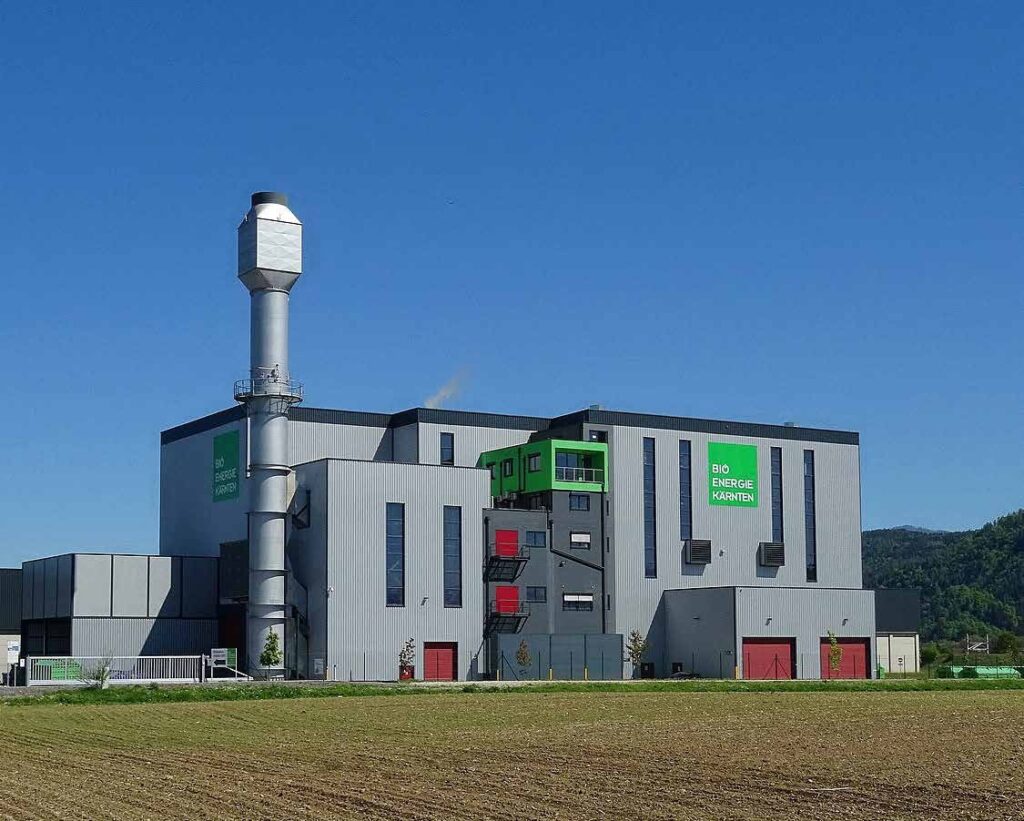

Figure 3.2 Comparing costs of different renewable energy technologies

The sun
The sun is the energy source provided by nature herself for the creation of life on Earth. So why not seek ways of using the sun’s energy directly? The midday sun heats every square metre of the earth with a solar capacity of about one megawatt.
Any room with windows grows warm when the sun shines. If the sun is shining in from your window, but it is quite chilly inside the house, open your curtains and wipe any dust off the windowpane, and the sun will bring a little more heat into your room. In the old days, in European villages, people used wooden shutters on windows. In the daytime the window was opened to let in light and at night it was closed with shutters to keep the captured warmth inside the house.
With the advance of science, people have learnt better techniques to ‘catch the sun’. There are two main ways of using the sun’s energy.
Units of measurement of electric power
Watt is a unit of power. One watt is defined as one joule per second (1 J/s), representing the rate of energy transfer or conversion of one joule of energy per second.
- 1 watt (W): the power of the transmitter in a standard mobile
- 1 kilowatt (kW, 1,000 W): the power of a small heater, approximately equal to the heating of one square metre of land by the sun at
- 1 megawatt (MW 1,000 kW): railway locomotives have average power between three and ten
- 1 gigawatt (GW, 1,000 MW): the unit to measure the power of the largest electricity generating plants in the world.
- 1 terawatt (TW, 1,000 GW): the peak power of a lightning
Solar collectors capture the heat of the sun. Water flows along tubes inside the collector and becomes warm (air or antifreeze is sometimes used instead of water). Such collectors can be used for heating buildings and to provide hot water.
Photovoltaic cells are another popular method to collect and store solar energy. Photovoltaic cells convert sunlight into electrical energy. We are all familiar with calculators that use photovoltaic cells and garden lanterns that collect energy during the day and provide light at night. Large solar energy power stations – so-called ‘solar farms’ – operate on the same principle.

Photovoltaic cells can also be used to power various means of transport: boats, cars and even airplanes! In Italy and Japan, photovoltaic cells are installed on the roofs of trains to produce electricity for air conditioning, lighting, and alarm systems.
The main advantages of solar energy are that it is freely available, inexhaustible, and safe. Solar installations do not emit greenhouse gases or pollutants, so this method of obtaining energy does not harm the climate.
Solar energy: hot water plus electricity
Using the sun’s heat to generate energy has long been a common practice in countries with hot climates. In warm countries you often see tanks of water on the roofs of houses, which are heated by sunlight to be used for everyday needs.
In Israel, every building has to be equipped with solar panels for water heating. The city of Freiburg in Germany is a showcase for the potential offered by solar power, which is used to meet the energy needs of entire neighbourhoods. Similar experiments are increasingly frequent all around the world.

The disadvantages of solar energy are its strong dependence on the weather and time of day, and high manufacturing costs due to the use of rare elements in solar panels. However, new technologies are fast reducing the cost of solar installations and broadening the areas of their application. Recent data show that the cost of renewable power has fallen by 80% since 2010, leading to the rapid use of solar for electricity generation worldwide. However, there are problems associated with the disposal of used solar cells, since they contain toxic substances. A market for the recycling of solar panels has not yet taken shape, and panels have useful lives of several decades. Another drawback is the large consumption of energy and clean water to produce solar panels. Engineers are working on new, more environmentally friendly solar cells, and producers need to develop systems for the disposal and recycling of used panels.
How big are the largest solar power plants in the world? What about solar energy after sunset?
The largest solar power plant is the Talatan PV Power Station in China with a solar park that spans 609.6 km2. Reflecting the sheer scale of the Talatan PV Power Station is its capacity – a gargantuan 9 GW, which contributes to an average annual power output of 9,600 GWh. But the Talatan PV Power Station isn’t just one of the world’s leading examples of how the future of renewable energy looks – it’s a case study of how solar farms can transform the geographic and economic prospects of an area for the benefit of the people.
 The second largest solar thermal power plant in the world as of 2022 is the Bhadla Solar Park, in the Jodhpur district of Rajasthan, India. The Bhadla Solar Park is a 2.25 GW solar photovoltaic power plant and the largest solar farm in the world, encompassing nearly 14,000 acres of land. Its construction cost an estimated $1.4 billion. What are some of its benefits? It helps to reduce India’s dependence on imported fossil fuels. In rural areas, solar power provides a much healthier and safer source of indoor lighting than kerosene. Additionally, solar power plants like the Bhadla Solar Park drive economic growth and job creation in surrounding areas.
The second largest solar thermal power plant in the world as of 2022 is the Bhadla Solar Park, in the Jodhpur district of Rajasthan, India. The Bhadla Solar Park is a 2.25 GW solar photovoltaic power plant and the largest solar farm in the world, encompassing nearly 14,000 acres of land. Its construction cost an estimated $1.4 billion. What are some of its benefits? It helps to reduce India’s dependence on imported fossil fuels. In rural areas, solar power provides a much healthier and safer source of indoor lighting than kerosene. Additionally, solar power plants like the Bhadla Solar Park drive economic growth and job creation in surrounding areas.
The Solana Generating Station is located 110 km south-east of the city of Phoenix in Arizona, USA. It can generate up to 280 MW of power from the rays of the sun and is one of the most powerful solar power plants in the world using parabolic mirror technology. But what makes the complex special is not its size, but its ability to continue generating electricity for six hours after the sun has gone down by means of special reservoirs that retain heat. This is a valuable feature, since the time after sun- set is the time of peak electricity consumption in the region.
Many experts view solar power as the energy of the future and as one of the main alternatives to traditional hydrocarbon energy sources. Governments in many countries support the development of solar energy, and private companies are investing much money in the construction of solar power plants. China is the global renewable energy leader, hosting nearly half of the world’s total operating wind and solar capacity, followed by the US and India. Although not known as a sunny country, Germany is among the leading countries in the world in the development of solar energy. Other frontrunners are Spain, Sweden, Costa Rica, Iceland, Italy, France, Japan, Kenya, Morocco, New Zealand, Norway, Uruguay, and the UK. This list shows that solar power is becoming increasingly important for developed and developing countries and emerging economies. Importantly, solar power helps to provide distant villages in developing countries that are not connected to the grid with modern, yet cheap energy services.
Wind
Wind is another commonly used renewable energy source. The principle behind wind power is that mechanical energy (the energy of movement) can be converted into electrical energy. Miniature windmills and wind-driven toys are fun to play with, but if you build huge wind turbines and place them together in a windy area, the rotation of turbines can generate electricity for public use.
Windmills have been used since ancient times, but they became especially popular in medieval Europe. For a long time, windmills and water mills were the only machines known to mankind. Windmills were mainly used to grind corn into flour, to process timber or for irrigation. In the Netherlands, windmills pumped water from land that had been reclaimed from the sea so that the land could be used for agriculture.
Modern wind turbines use a principle analogous to that of windmills.
Wind turbines are usually located in coastal areas, where there is constant wind, and it has recently become possible to build such installations at sea as well as on land. So-called ‘offshore wind farms’ are now built 10–12 km or more from the coast. Wind turbine towers are set on pile foundations that are driven into the seabed to a depth of 30 metres. The latest technologies help the construction of wind turbines installed on floating platforms.


 Two offshore wind projects off the east coast of England are now among the largest operating projects in the world. They include the 1.32 GW Hornsea 2 and the 1.2 GW Hornsea 1 which comprise the largest operating offshore wind farm in the world. Hornsea 2 is 462 km2 and can power more than 1.3 million homes. Together, Hornsea 1 and 2 are capable of powering 2.5 million homes. The planned 2.8 GW Hornsea 3 project is expected to be in operation in the next few years. Another example is the Greater Changhua with a total capacity of 900 MW, making it the largest and first far- shore wind farm in Taiwan. This off-shore wind farm significantly supports Taiwan’s fast-track build-out of renewable power and provides it with the much-needed green energy to achieve its net-zero goal.
Two offshore wind projects off the east coast of England are now among the largest operating projects in the world. They include the 1.32 GW Hornsea 2 and the 1.2 GW Hornsea 1 which comprise the largest operating offshore wind farm in the world. Hornsea 2 is 462 km2 and can power more than 1.3 million homes. Together, Hornsea 1 and 2 are capable of powering 2.5 million homes. The planned 2.8 GW Hornsea 3 project is expected to be in operation in the next few years. Another example is the Greater Changhua with a total capacity of 900 MW, making it the largest and first far- shore wind farm in Taiwan. This off-shore wind farm significantly supports Taiwan’s fast-track build-out of renewable power and provides it with the much-needed green energy to achieve its net-zero goal.
A large wind farm may consist of several hundred turbines extending over a large territory (up to several hundred square kilometres). Wind farms are connected to a country’s electricity grid and transmit electricity over long distances. Smaller wind farms or stand-alone wind turbines can be used to supply electricity in remote districts or to power small facilities.
In 2022, wind power provided more than 2100 TWh of electricity, which was over 7% of the world’s electricity production, and more than all other non-traditional renewable energy sources combined. It is a rapidly growing source of power as new, more advanced technologies are invented, which allow wind energy to be used more efficiently.
The share of wind and solar is rising constantly (+1.5% in 2022), reaching 12.2% of the energy mix for electricity generation in 2022. Experts at the International Energy Agency predict that wind and solar power will grow even faster in the current decade and together could produce up to 18% of the world’s electricity by 2026. Along with traditional hydropower, the share of wind and solar (also called variable renewables) will reach 37% by that year.
Wind energy already has an important role in some European countries. Denmark has been a global leader in solar and wind power production. In 2023, wind power accounted for over 57% of the country’s electricity generation, compared to 1994, when coal accounted for 83% of electricity production.
Figure 3.1.7 Wind farms in Kansas, USA (above) and Austria (below)
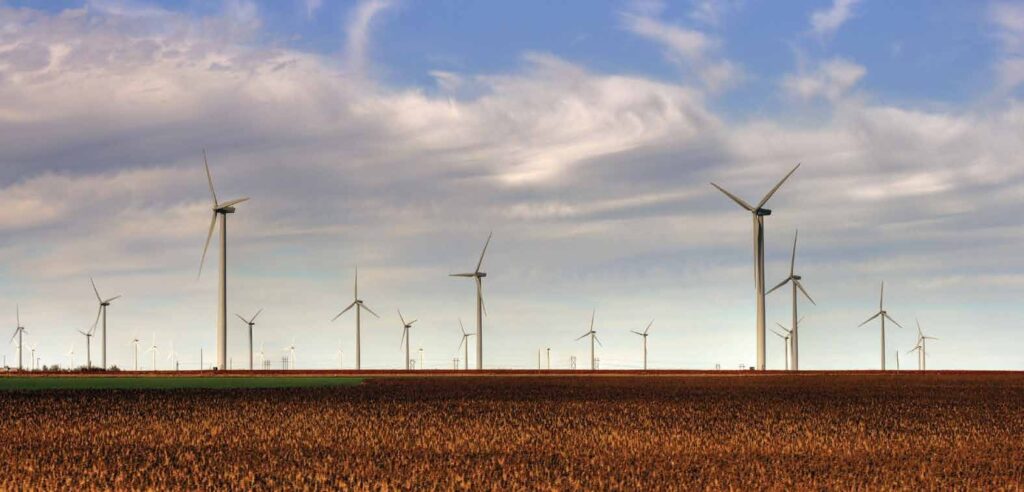
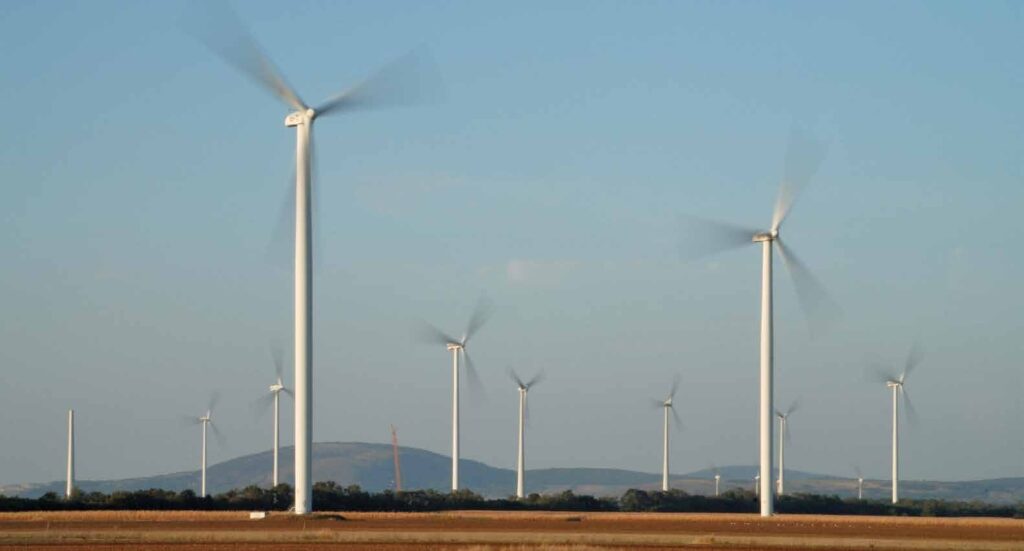

Water
The energy of moving water can be harnessed in many ways.
The most common is hydropower: the flow of a river rotates a turbine, which produces electrical energy.
This sounds simple, but hydropower has its drawbacks. To create a powerful and efficient hydroelectric power plant, you must build a high dam so that all the river’s power can be channelled to rotate the turbine blades. The construction of such a dam upsets the natural life of the river: it may alter the river’s microclimate, destroying or harming the animals and plants that live there. This is why the construction of a hydroelectric power plant must be approached very carefully, paying due attention to environmental balance.
The maintenance of large dams also requires constant attention: if an accident causes the dam wall to burst, the water that is released will gush down the river valley, sweeping away everything in its path, and breaking the banks of the river for miles downstream. For example, the collapse of the Bantsao hydroelectric dam in 1975 in China killed more than 200,000 people unofficially (26,000 according to official sources).
Figure 3.1.8 Schema of a hydroelectric power plant and a dam
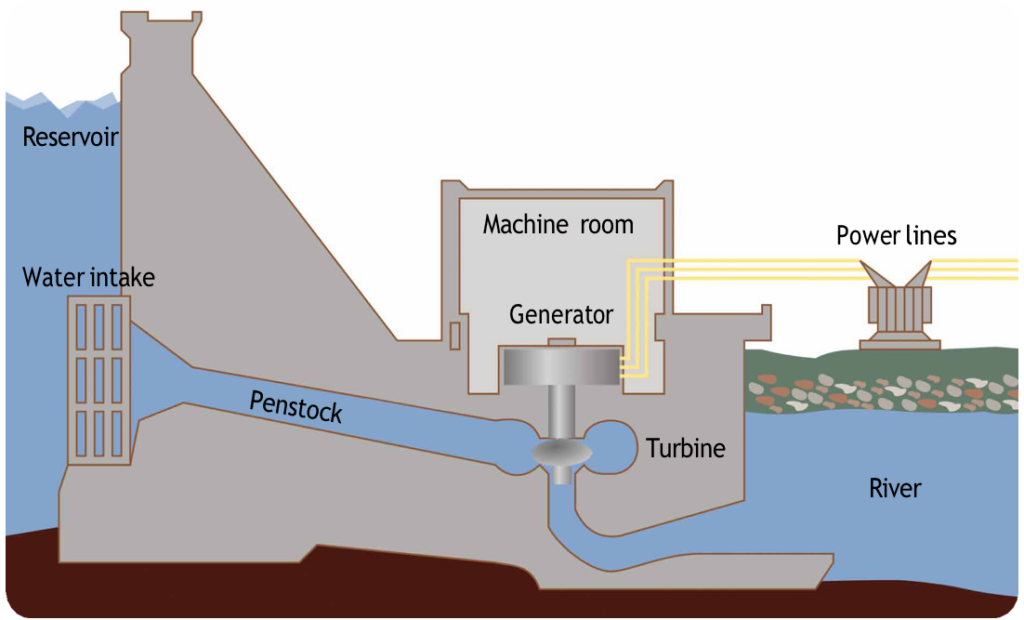
Small hydroelectric installations can operate without a dam (Fig. 3.1.9). They are built on small rivers or even on streams, and store energy in a battery. They have limited power but are adequate to meet the needs of a small farm or essential services at a wildlife reserve located by the river.
Hydropower is safer for the climate than traditional thermal power and costs only about half as much to produce. As a result, many countries are trying to maximize the potential of their rivers for energy production. In some countries hydroelectricity provides 90-100% of all electricity (Paraguay, Norway, Tajikistan, Uruguay, Uganda, Zambia, Namibia, Cameroon, and Brazil). China has a strong commitment to hydroelectric power: up to half of all the world’s small hydropower plants have been built there as well as the biggest, the Three Gorges plant on the Yangtze River with capacity of 22.5 GW (Fig. 3.1.10). An even bigger plant, called Grand Inga, with capacity of 39 GW is planned on the Congo River in the Democratic Republic of the Congo in Africa. Brazil and Canada are also key producers of hydropower.
Figure 3.1.9 Small hydropower plant on the Kokra River in Slovenia

Figure 3.1.10 Three Gorges hydropower plant, China

Figure 3.1.11 Yacyreta Dam on the Parana River, Paraguay, Argentina
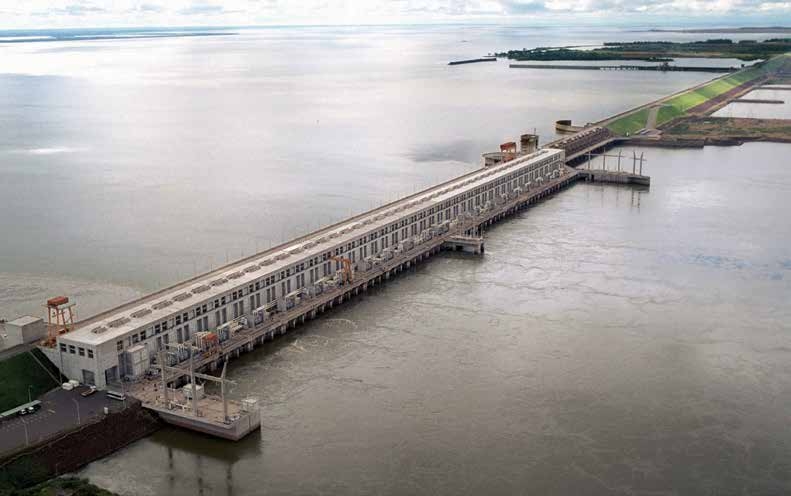
Wave power stations use the energy of waves in the ocean, which is essentially the energy of a float bobbing up and down on the sea. Thus, the churning power of the ocean, so dreaded by sailors in the past, can be made to serve us. The power of the waves is dozens of times greater than that of the wind if it can be harnessed.
Tidal power plants use the extraordinary phenomenon of tides. All planets, stars and other celestial bodies are linked by gravity and affect one another. Earth revolves around the Sun and around its own axis, the Moon revolves around Earth, and the positions of the Sun, Earth and Moon change all the time. This affects the ocean.
A dam is built at a point across a bay where tides are strong. Initially it prevents the rising water level from entering the bay, until the tide level is close to its maximum point. Then a valve is opened, and the ocean water rushes through with great force, turning a rotor. When the water level on both sides of the dam has equalized, the valve is closed again. When it is low tide and the ocean is in full retreat, the trapped water presses to leave the bay, and is allowed back out through the valve, turning the rotor once again.
Experiments using wave energy have been attempted since the end of the 18th century: the first patent for a mill driven by wave power was taken out in 1799. But a long time was to pass before this form of power could be used on a large scale. There are also tidal power stations that rely on gravitational forces, unlike wave power stations that rely on wind and waves.
The first large wave power station was opened in 2008 in the Agucadoura region of Portugal, five kilometres from the coast. The station has 2.25 MW capacity.
Another large wave power station with comparable capacity is the Sotenäs wave farm in Kungshamn, Sweden. The plant consists of 36 wave energy converters (WECs), with a total installed capacity of nearly three MW.

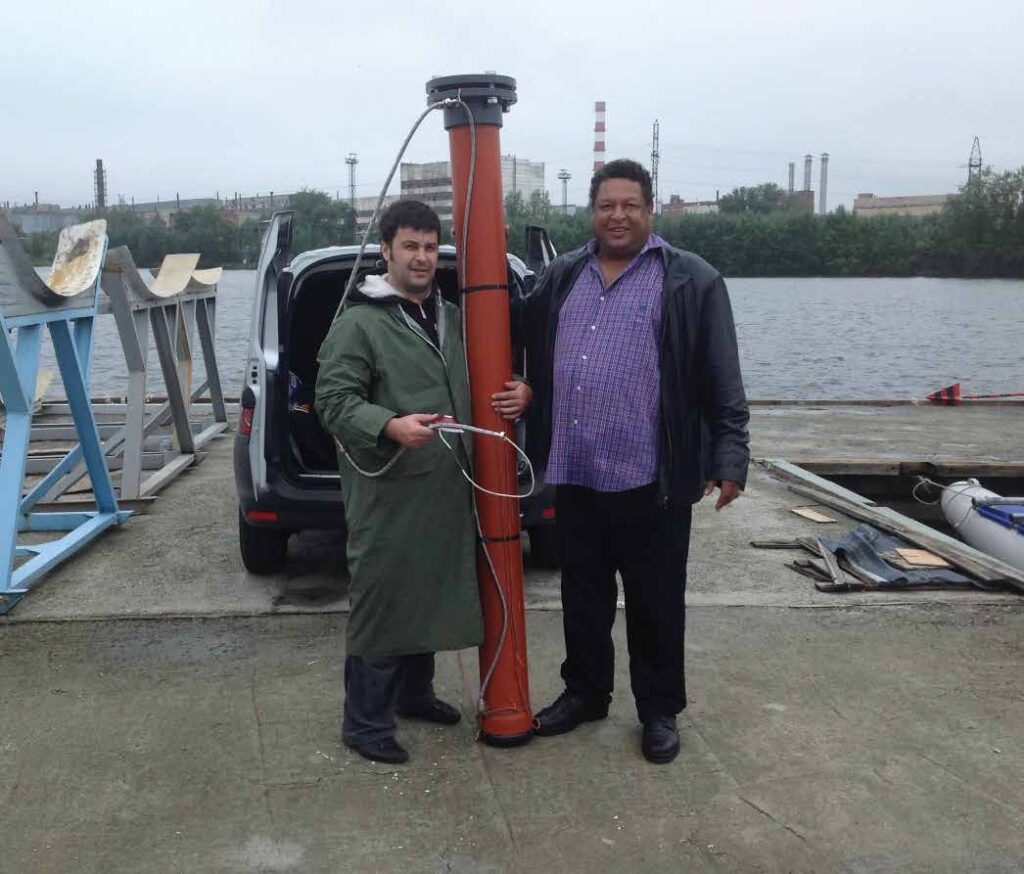
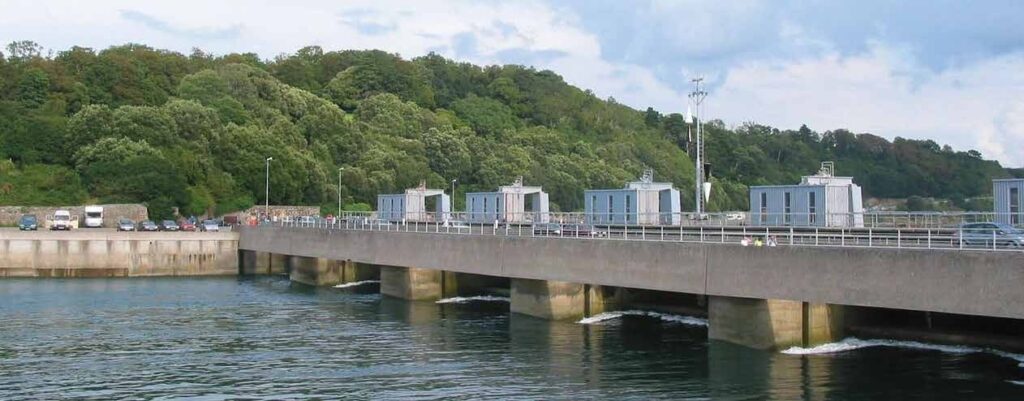
The Rance Tidal Power Station in Brittany, France is the oldest tidal installation in the world. Since 1967, it was also the largest tidal power station by installed capacity until the Sihwa Lake Tidal Power Station in the Republic of South Korea surpassed it in 2011. The Rance power station has 24 turbines that reach peak output at 240 MW and average 57 MW, a capacity factor of approximately 24%. At an annual output of approximately 500 GWh, it supplies 0.12% of the power in France. The cost of electricity production is estimated at €0.12/kWh. The difference in level between high and low tide in this part of France averages eight metres and can be as great as 12 metres.
Geothermal energy
Geothermal energy uses heat produced by the earth. It cannot strictly be called ‘renewable,’ but the stocks of heat in the depths of our planet are immense. Evidence of the heat contained in the earth is visible in areas of volcanic activity, where hot underground water sometimes rises through cracks in the earth’s surface and occasionally bursts upwards in the form of jets of water and steam known as geysers.
A borehole can be drilled to hot underwater lakes and their water used for heating or electricity generation, and as a supply of hot water (if the chemical composition of the water is suitable). A key problem with hydrothermal energy is that used water must be returned to the ground, since it often contains chemicals that would be harmful if released into rivers and lakes. Another is that use of water from underground lakes leaves voids, which could lead to surface subsidence.
Another possibility is to pump ordinary water from the surface via a borehole into hot zones under the ground, where it is heated by a ‘natural boiler’ to boiling point and returns to the surface through an adjacent borehole in the form of steam. This is called petro-thermal energy. Petro thermal projects have been developed in the United States, Australia, Japan, Germany, and France.
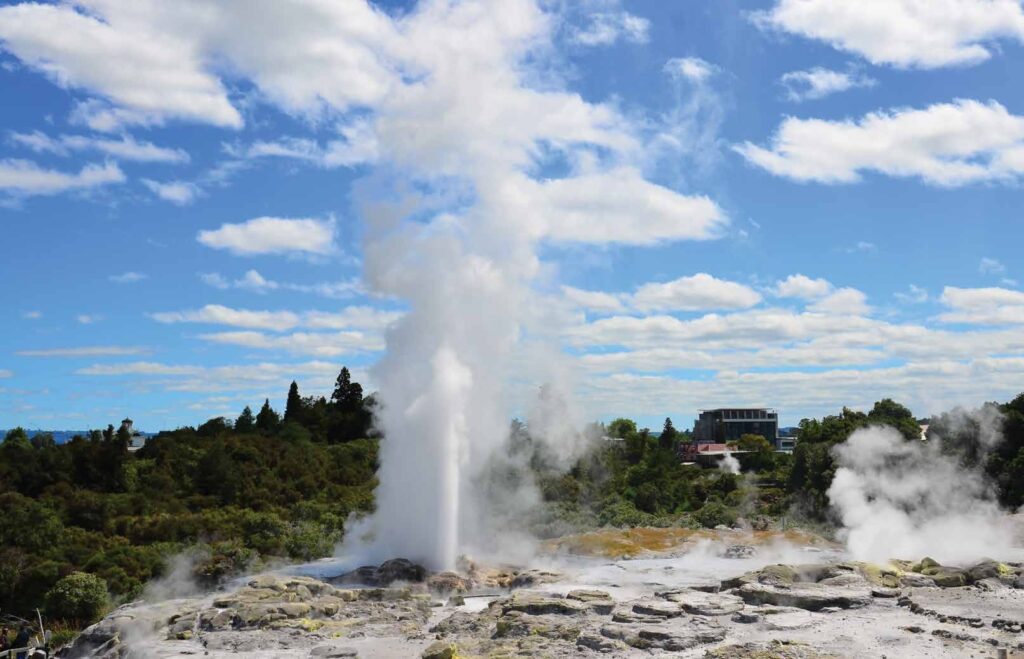
The world’s largest and most powerful geothermal field is located north of San Francisco in the USA. Called The Geysers, it consists of 22 geothermal power plants with a total installed capacity of 1,517 MW.
In the Philippines and Iceland, both countries with major active volcanoes, geothermal power plants provide about one quarter of all electricity consumption. New Zealand, Indonesia, Japan, and Italy also make extensive use of geothermal energy.
Figure 3.1.12 A pipe at a geothermal power station

Low-grade heat
Refrigerators rely on several principles for their proper functioning. The key principle is this: a liquid cooling agent (the refrigerant) absorbs heat from inside the refrigerator and a compressor then sucks and compresses the cooling agent under pressure, outside the refrigerator, so that (by the laws of physics) the absorbed heat is emitted into the air of the room where the refrigerator is kept.
This is why if we touch the outside rear part of a refrigerator, we find that it is hot. It is also why a refrigerator should stand away from heating appliances and not be directly in the sun – because it is important that the heat it emits is quickly dissipated in the surrounding air and not retained in its external walls.
The point of a refrigerator is to retain cold and get rid of heat, but the same operation can also be carried out in reverse, so that heat is retained and cold discarded. A device which does this is called a heat pump.
Heat pumps can absorb heat from weakly heated liquid, air or other substances. They can also ‘take up’ the heat of the earth at shallow depths. If in the winter you pass the warm air coming from your apartment or the used warm water draining out of the bath through a heat pump, a substantial part of the outgoing heat can be returned to your apartment. However, a heat pump cannot heat water to a very high temperature. The upper limit is usually no more than 50 or 60°C, which makes it a supplementary and not self-sufficient energy source to reduce fuel consumption for heating.
Nevertheless, scientists consider heat pumps a key technology in practically all future scenarios leading to zero emissions in 2050, as they not only use renewable energy but offer efficiency gains that are two to four times more than conventional heating systems. This is why the number of heat pumps installed is growing fast and by 2050 is expected to see a tenfold increase.
Just in Europe, heat pump sales have soared because of technology improvements and cost reduction. The rapid fall in production costs of PV systems also influences the heating market: using self-produced electricity in combination with a heat pump system provides buildings with a low-cost energy source.
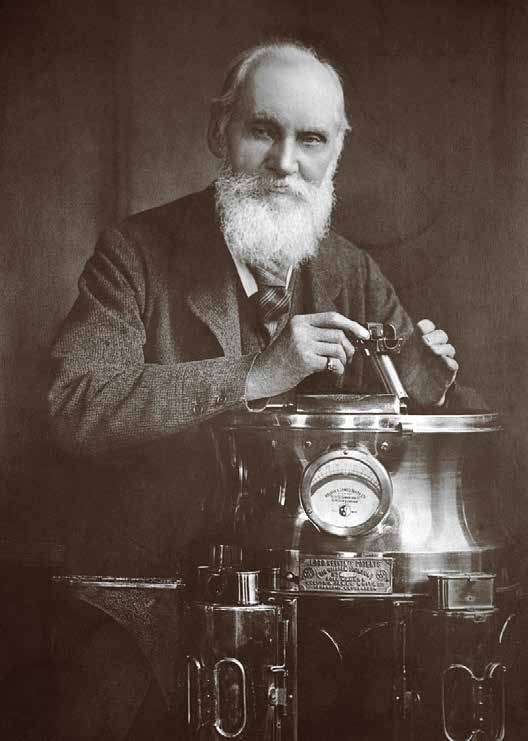 The concept of heat pumps was developed in the 19th century by the British scientist, William Thomson (Lord Kelvin), and was further improved by Peter Ritter von Rittinger of Austria. But the most important practical application of heat pumps was only developed in the 20th century. An inventor, Weber, who was carrying out experiments with a freezer chamber, touched the hot pipe of the chamber and began to wonder how this heat could be used. He thought of using the hot pipe to heat water, but that produced too much hot water, so he instead made a pipe coil to warm the air in the house. Weber then found a way of pumping heat from the ground. Soon he was able to sell the old coal burner his family had relied on, as it was no longer needed!
The concept of heat pumps was developed in the 19th century by the British scientist, William Thomson (Lord Kelvin), and was further improved by Peter Ritter von Rittinger of Austria. But the most important practical application of heat pumps was only developed in the 20th century. An inventor, Weber, who was carrying out experiments with a freezer chamber, touched the hot pipe of the chamber and began to wonder how this heat could be used. He thought of using the hot pipe to heat water, but that produced too much hot water, so he instead made a pipe coil to warm the air in the house. Weber then found a way of pumping heat from the ground. Soon he was able to sell the old coal burner his family had relied on, as it was no longer needed!
Biomass
 The living plants we see around us today use photosynthesis to accumulate energy from the sun in their bodies. A bonfire or the fire in a fireplace warms us because a tree that people cut down for firewood spent years capturing energy from the sun and gathering carbon dioxide from the air. Trees have worked for us storing up energy when they were alive, and they finally yield that energy to us when they burn in a fire.
The living plants we see around us today use photosynthesis to accumulate energy from the sun in their bodies. A bonfire or the fire in a fireplace warms us because a tree that people cut down for firewood spent years capturing energy from the sun and gathering carbon dioxide from the air. Trees have worked for us storing up energy when they were alive, and they finally yield that energy to us when they burn in a fire.
It takes nature several hundred million years to create fossil fuels, so (at the rate we are using them) they are not being replaced.
But biomass fuel can be easily replaced: if we cut down an old tree for fuel, we can plant a new one in its place, which will grow into a new tree in a few decades. Some plants and agricultural crops used to make fuel grow in one summer or even faster.
But let’s think: many of us have been kept warm and had a nice time sitting around a campfire, or looking at the flames dancing in an outdoor stove in the summer, but how many trees have we planted to pay nature back for that wood? It is simple enough to cut down forests and use the wood. But how often do we plant new trees to make up for the ones cut down?
It is not just trees that can be used as fuel. Parts of plants generally considered to be waste – e.g., husks from cotton plants, straw from wheat, stones from fruit – are also good for fuel. Plants absorb about the same amount of carbon dioxide during their lives as they release when they are burnt. If they had died in the natural environment instead of being used for fuel, roughly the same amount of gas would have been given off gradually as was obtained from their combustion. Biomass is a relatively safe source of energy, but it is not always a good option: for example, it makes good sense to use the offcuts from woodworking as fuel, but if we cut down healthy trees for firewood, we are wasting valuable natural resources.



The easiest and most common way of producing energy from biomass is by burning it. But you can only make a bonfire with dry and resinous wood, and you must make sure that the bonfire is laid in a way that will let it burn. So, scientists are working to design more economical technologies, which will let us burn raw biomass that is damp or has mixed ingredients in a more efficient and environmentally friendly way.
Plant fibre can be burnt to obtain energy directly, or transformed into a universal fuel that is easier to transport and use in various existing machines and devices. Plants containing oil can be used to produce various liquid diesels (biodiesel). Plant products that contain sucrose and starch can be used to produce alcohol (ethanol), which is also used as fuel.
There are different types of biofuels. Ethanol and biodiesel are the primary fuels used by cars and trucks. There are also conventional biofuels produced from sugar and oils in arable crops, as well as advanced biofuels produced from products such as forest and agricultural residuals.
Concerns over the sustainability of production of biofuels and competition for land for food production is increasingly shifting attention to advanced biofuels. In addition to saving on CO2, these fuels are also part of the so-called circular economy.
Figure 3.1.13 Types of biofuels

Brazil is among world leaders in the production and use of ethanol from sugarcane.
The ethanol produced in the country meets 18% of its automotive fuel needs.
Figure 3.1.14 Bioethanol plant in Brazil

Figure 3.1.15 At a filling station in Brazil you can fill your car with biofuel.

Amazing sources of energy
 Australia now has the world’s first electric generating facility that uses nutshells as fuel. Its construction cost AU$3 million, but it should pay for itself quite quickly: the high-performance power plant can process up to 1,680 kg of nutshells per hour to produce 1.5 MW of electricity.
Australia now has the world’s first electric generating facility that uses nutshells as fuel. Its construction cost AU$3 million, but it should pay for itself quite quickly: the high-performance power plant can process up to 1,680 kg of nutshells per hour to produce 1.5 MW of electricity.
Indian scientists have come up with another alternative energy source, using bananas, other fruits and vegetables, and their inedible parts (peel, seeds). Four batteries powered by these fuels can operate a wall clock, an electronic game, or a pocket calculator. This energy is primarily for people in rural areas who have an abundance of their own fruit and vegetables to recharge the batteries.
 In the not-too-distant future, people might be able to generate electricity from the movement of their own bodies. US researchers are developing special shoes with plastic inserts: when a person walks, their feet alternately press and release the inserts, causing them to shrink and expand. This movement can be used to generate up to three watts of electricity, enough to listen to the radio or to music as you walk, saving on batteries.
In the not-too-distant future, people might be able to generate electricity from the movement of their own bodies. US researchers are developing special shoes with plastic inserts: when a person walks, their feet alternately press and release the inserts, causing them to shrink and expand. This movement can be used to generate up to three watts of electricity, enough to listen to the radio or to music as you walk, saving on batteries.
Fermentation is another way to use biomass.
Farm animals, which eat and digest plants, produce manure that can be used to generate energy. If manure and food waste are collected in a closed container which is then heated to 50–60°C, bacteria will break down the organic matter to produce methane gas, which can be collected and used as fuel.
Every year the world produces and uses or destroys about 170 billion tonnes of primary biomass.


